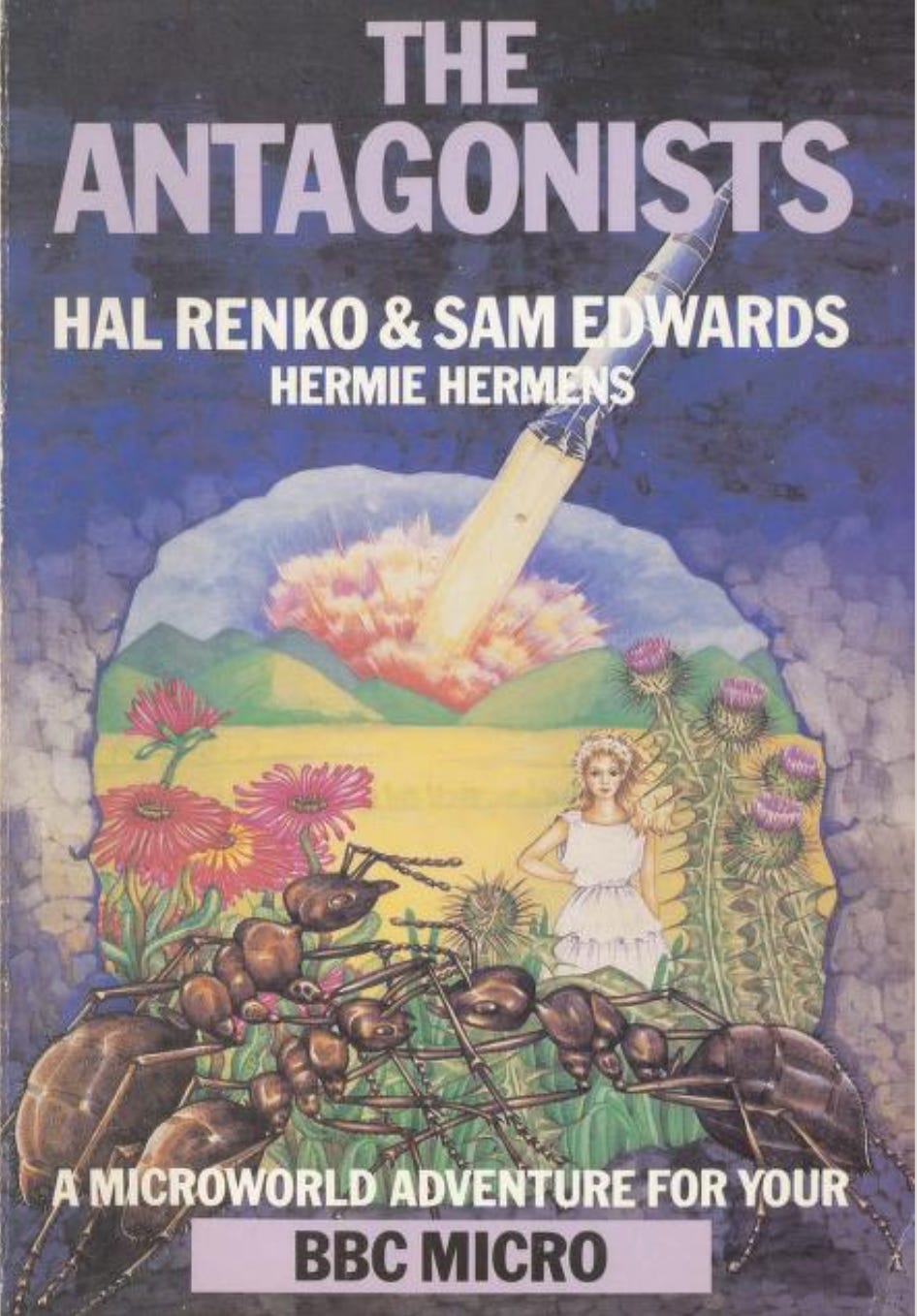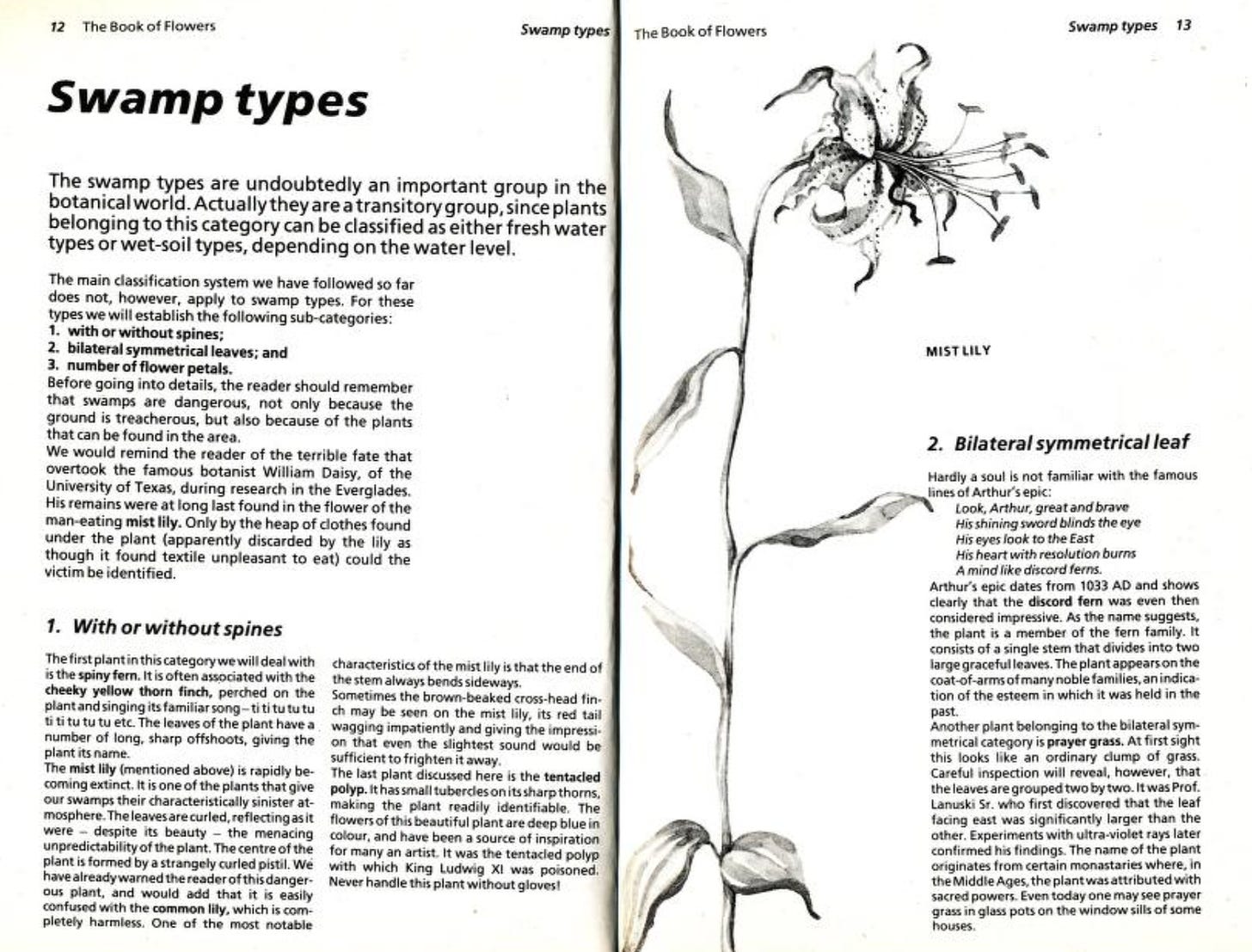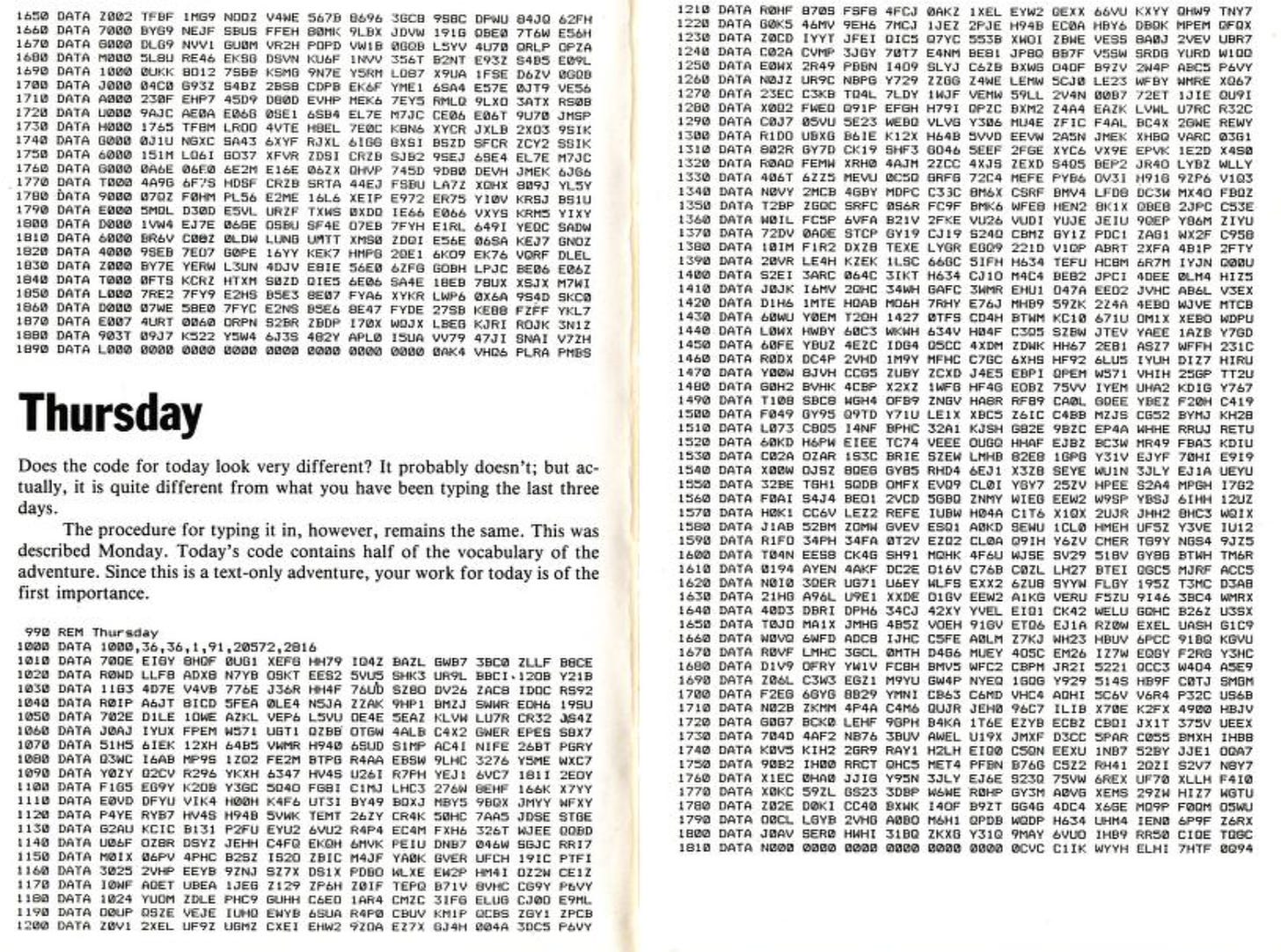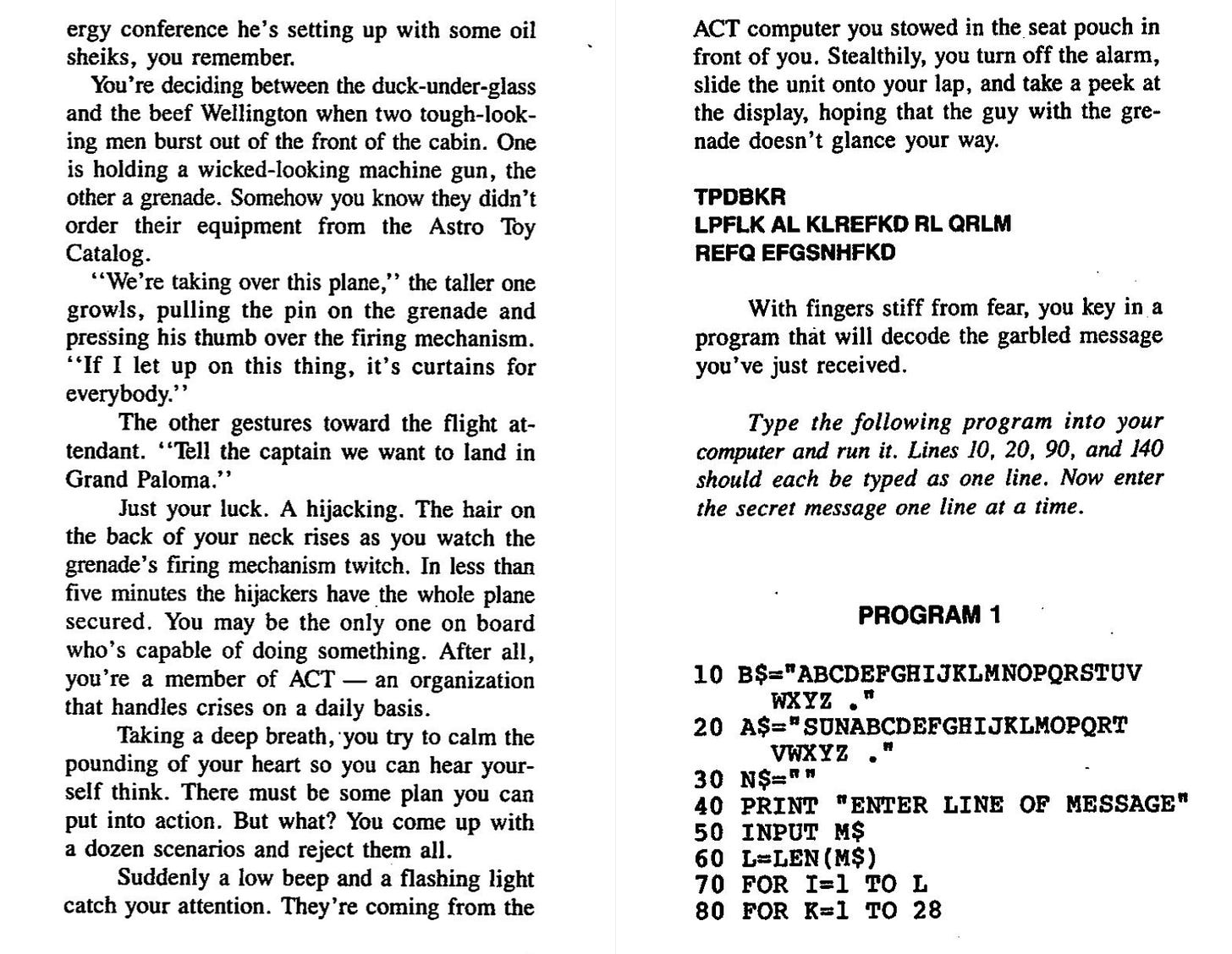Inventory update: the 50 Years of Text Games book remains officially sold out, but as all orders have now shipped, I’m expecting to have a small stock of copies available out of the inventory I was holding back for lost shipments and other emergency contingencies. Expect a fire sale of these last few copies in a few weeks, which I’ll announce here!
In the meantime, here’s a fun new article on an obscure piece of interactive fiction history: the lost art (or, perhaps, well-buried curse) of the type-in game. Thanks to Chris Charla who commissioned this piece which first appeared in his print zine Incredibly Strange Games.
The Antagonists
by Hal Renko (Kasper Boon), Sam Edwards (Alex Pelsmaeker), and Hermie Hermens
Language: BASIC
Published: 1985 (print, Addison-Wesley, in English editions for ZX Spectrum, Apple II, PC/PCjr, and BBC Micro/Electron; and in Dutch editions for ZX Spectrum and Commodore 64)
In the 1980s, no one was quite sure what computer games might become. Were they a first step toward interactive movies? Digital versions of tabletop roleplaying games? For a while, the publishing industry was quite keen to turn them into interactive books, and a “bookware” boom featured text adventure adaptations of popular novels from authors like Anne McCaffrey and Stephen King.
But turning a book into a computer game was only one way to do it. With a certain dash of perversity, one might instead consider the option of selling a computer game that took the form of a book.
Games had been shipped alongside books and printed stories before. The bookware version of The Hobbit was famously bundled with Tolkien’s original novel, and Infocom included elaborate “feelies” with their text adventures containing lore, hints, and worldbuilding. But such add-ons generally served more to prop up the game they accompanied than as equal partners. In 1985, Addison-Wesley (who had handled the US release of the Hobbit game) published a pair of books that hoped to change this, promising
an exciting new approach to adventure gaming: you are not alone! Instead of being left in the dark, not knowing whether LEFT or RIGHT will lead to treasure or trouble, you have at your side a collection of documents and details, pictures and practical guides.
The idea was a book and a game that truly worked together. Each title in the series would be a full printed book containing a dossier of stories and documents from a fictional world, ending with the source code listing for a game that could only be completed after thoroughly understanding that world. In the prototype and first published book in the series, The Secret of Arendarvon Castle, these documents concerned the haunted Scottish home of an ancient magician. In The Antagonists, which followed a few months later by mid 1985, they comprised nearly a hundred pages of diary entries, botanical guides, drawings and sketches, travel brochures, and guidebooks from a strange, apocalyptic future.
The format was conceived by a pair of Dutch academics, Kasper Boon and Alex Pelsmaeker, who had been publishing well-regarded computer books for the US and UK markets since the early 1980s (with titles like Cosmic Games for the Commodore VIC 20 and Terrific Games for the TI99/4A). Boon, a medical imaging scientist for whom both writing and computers were a side hobby, adopted the pseudonym Hal Renko to avoid interfering with his professional reputation; Pelsmaeker (aka Sam Edwards) had started an engineering firm called Omikron while still a master’s student, which mostly worked on industrial automation software but provided connections and resources to moonlight in game design, too. In 1984, approached by Addison-Wesley with a nudge to try something more creative, the pair brought on talented student Arend Rensink to write a new game engine and design the self-named Secret of Arendarvon Castle; for The Antagonists, Hermie Hermens stepped in to replace Rensink. The key idea behind the series was to do something more exciting and elaborate than other computer game code books, which usually featured simple, one-page programs with minimal, if any, narrative. What if, instead, both story and code could grow complex enough to be really interesting? What if a book and a game could work together to be something truly unique?
The book part of The Antagonists presents itself as a collection of documents curated by one Albert Renshaw, the last human survivor on an Earth conquered by giant plants and enormous insects (the antagonists). Renshaw lays the blame for humanity’s downfall on the development of an artificial growth hormone to fight malnutrition that went horribly awry. But typical of the book’s quirky worldbuilding, it also identifies a motley set of other causes for the fall of civilization, including the proliferation of unnecessary work meetings, the rise of rock music, and an unwise mingling of scientific disciplines (giving rise to such fields as “chemical sociology,” “the psychology of data networks,” and even “mathematical art.”)
Renshaw lays out his plans to escape Earth in a series of steps which readers soon realize describe their goals in the companion computer game:
First, I must try to reach the caves. I know it’s absolutely dark there, and that many dangers lie in wait.
Perhaps I can make use of the glow-worms out in the fields to light my way. I must remember to collect enough nectar from the flowers in the open fields to keep my little friends alive during my journey through the caves. It will be a good idea to take the “Book of Flowers” with me too, so that I can determine exactly which flowers produce nectar in reasonable quantities, and whether they are dangerous or not.
A close reading of the book is meant to inform a successful playthrough of the game. For instance, as you explore the early parts of the game, you do indeed find a dark cave you can’t explore, and a glow-worm who needs feeding to be useful. To find the right food, you’ll need to explore a map filled with enormous plants, each spanning multiple rooms:
A HUGE PLANT WITH A THIN STEM GROWS HERE ON THE DRY PLAIN
YOU CAN GO EAST
YOU CAN GO WEST
YOU CAN GO NORTH
YOU CAN GO UP
WHAT DO YOU WANT TO DO NOW?
>UP
YOU WENT UP
TWO BIG LEAVES SPROUT OUT OF THE STEM
YOU CAN GO NORTH
YOU CAN GO SOUTH
YOU CAN GO UP
YOU CAN GO DOWN
WHAT DO YOU WANT TO DO NOW?
>UP
YOU WENT UP
YOU'RE IN THE CALYX OF A RED FLOWER
YOU CAN GO DOWN
YOU SEE A DROP OF GOHHONEYTurning in the book to the twenty-page “Book of Flowers,” you’ll find a dense field guide to unfamiliar plants with names like whisker yarn, prayer grass, and briny gooseberry. Careful consultation identifies the plant above as a “dry darnel,” which grows in dry soil, has a “thin stem,” and flowers in a “vivid red color.” Through exploration, note-taking, and deduction, the player can work out which plants have the best food for their glow-worm, and successfully move on to the next part of the game.
The book’s worldbuilding is a little quirky, and doesn’t always connect so directly or successfully to the game. Sci-fi and post-apocalyptic plots mingle with more fantastical elements, such as two races of fairy-like creatures who emerge as humanity begins to decline. The fictional documents in the book are crenelated with introductions and afterwards, notes from scholars, and corrections from later editors. Sprinkled throughout are various implicit and explicit signs of a civilization heading toward downfall, and the book seems to take a particular delight in poking fun at academics and their claims to absolute truth. The Book of Flowers, for instance, is encrusted with a genealogy of prefaces for prior editions, tracking a succession of competing editors who trade veiled barbs about petty grievances and childishly revert each others’ inconsequential changes back and forth. The scholars and scientists in the book are presented as completely unable to solve or even recognize the impending doom of increasingly intelligent insects on their doorstep:
Last year a wolf ant nest was reported to have been found which contained doors that could be bolted at one side (Fidderley et al, 2255). Of course, incredible reports like this can hardly be taken seriously. If the report is true, it would mean that the ants now have tools at their disposal. Bruckenbach, of the University of Berlin, rejected this possibility after carefully investigating 4236 nests. Montaigne, of the University of Montreal, studied the feasibility of bolted doors using a simulation model, and arrived at the same conclusion.
When the connection between book and game works, The Antagonists can be a unique kind of fun: a story told simultaneously in two media, the player tasked with navigating both together. But the balance proves hard to maintain, and most of the blame for this stems from the need to keep the game small enough that its source code could be published in a book. As a consequence, the digital side of The Antagonists is simply too primitive to be the equal partner the premise demands.
The parser, for instance—which would already have felt old-fashioned by 1985—recognizes only a dozen unique verbs: all you can do with objects, for instance, is EAT, TAKE, or DROP them. Without a robust set of actions, gameplay must fall back on already tired tropes like mazes and lock and key puzzles. There are several NPCs, but no verbs to interact with them other than ATTACK. While the book spends breathless pages detailing the differences between the two fairy races, as if this distinction will become vital during play, it ends up not really mattering. The map is surprisingly large, but many room descriptions are so uninspired as to barely register, a consequence not only of limited space but perhaps a rushed pace of development:
YOU'RE INSIDE THE OLD COTTAGEYOU'RE IN FRONT OF THE OLD COTTAGEYOU'RE EAST OF THE COTTAGEEAST OF YOU THERE ARE BARREN ROCKSYOU'RE EAST OF A BARREN ROCKYOU'RE IN THE WESTERN SERVICE CORRIDORTHE CORRIDOR GOES ONTHIS IS A STORAGE ROOMThe game’s source code fits into fourteen densely encoded pages at the back of the book, an impressive feat (though not one without consequences, as we’ll see). Printed source code was not then an unusual means of distributing simple programs, though it was on its way out as disk drives dropped in price and software distribution channels rapidly matured. Many popular computing magazines still printed “type-in” game or utility programs in each issue, usually in the popular language BASIC. Hundreds of books collecting such type-in programs proliferated between the late 1970s and mid-1980s. Even MAD magazine printed a type-in in its October 1985 issue: “Here’s a great way to waste time, energy, and money!” the editors wrote. “You can try this program on a Mac,” they added, “but it won’t work.”
The snide comment alluded to a challenge facing type-in publishers: a sea of incompatible computer systems were still competing on the open market, each with their own slightly different versions of BASIC. Editors could try printing the code for one system alongside instructions for converting it to run on others, but this could get fiddly, with subtle changes often cropping up in multiple places throughout each program. A more costly approach was to print versions for each system separately. The book of The Antagonists was published in four different versions, for the ZX Spectrum, Apple II, PC/PCjr, and BBC Micro (not to mention editions in the authors’ native Dutch for the Spectrum and the Commodore 64). This solution was the clearest for readers, but created logistical headaches for publishers and distributors juggling multiple variants of the same core book.
Typing in a program could be fun, in theory: you couldn’t help but learn something about BASIC and how its code was structured. Many programmers who grew up in the 80s credit type-ins as their first introduction to coding. But a readable BASIC listing would be problematic for a project like The Antagonists for two different reasons. If the program’s text strings and logic were clearly visible, it would spoil the game’s puzzles and secrets. And financially speaking, a clearly-formatted and uncompressed BASIC listing would require printing far more pages. The solution to both problems was to print the program as a compressed stream of encoded data. But this turned the process of typing it in from a fun learning exercise into something more akin to a nightmare:
990 REM Tuesday
1000 DATA 1000,36,29,1,256,15629,2471
1010 DATA 2000 15XR 3NYI 0VPN S8BR ZBDP ME46 FYOE 17SB 4EJ7 E271 OKHM
1020 DATA T000 01JK 7VV9 FY7E 16SA 4E27 E06F Y9E1 6SA4 E07E 06JC 7E06
1030 DATA 5000 01XR ZES0 CRZB UKBA 4BQL N6VX ZRJY LS6N 699S 0CSH CTXD
1040 DATA 7000 0D3E J710 K0M6 IHLH RS0B 6L8E 09E2 7E06 I26E 2UE1 6SBM
1050 DATA E000 24VR 1UT0 95ZB RFRU 2BUD V6LN SB4E B7E0 C6XY 6RJX M66H
1060 DATA 0000 0DPE K7E0 8IW7 E2QE 16E3 IE28 EK7E 0AFW B6XY 6RJX Q9CI
1070 DATA X000 08ZE K7E0 CEH9 E2QE 16E7 ZE3B EK7E 0EJB 96XY 6RJX UBJJ
1080 DATA B000 0DYE K7E0 BJQ9 E2QE 16SL AE48 EK7E 0II3 A6XY 6RJX YARL
1090 DATA R000 0B40 AJYL 6C2S 4DSJ CRZQ YZBX FPS5 BRZH S0CS MCTX MS0C
1100 DATA U000 0BRQ LDE1 6E0C E27F 27FY H6WX YRWI SYJ0 VRRS DHTZ MS0B [...]The comment “Tuesday” at the top of this block refers to the book’s suggestion that typing in the game will be made easier by doing it over the course of a week, helpfully dividing the process into seven chunks each estimated to take an hour and a half to type. (The back cover of the book, somewhat misleadingly, characterizes this as an “easy” and “simple task”; the inside, more honestly, calls it “work.”) Typing in random symbols was not only incredibly tedious but also more prone to mistakes compared to readable code—and every single character would have to be entered perfectly for the program to work.
This was not as impossible as it might seem: as in compressed type-in programs published elsewhere, an error-checking mechanism based on checksums could pinpoint the line number of an input mistake. But this process itself further complicated the steps needed to get the game to run. The Antagonists source listing in fact consists of multiple programs: a decoder to error-check the compressed listing and convert it into assembly code, which included a virtual machine for interactive fiction; a block of data for that VM to read which defined the text, map, and behavior of the game itself; and a runner program to start up the VM, load the data block, and execute it. The instructions for getting this whole mechanism up and running were rather elaborate, with a series of procedures that had to be followed exactingly for the game to eventually run.
With so many points of failure, it’s perhaps inevitable that something, somewhere, would go wrong. It wasn’t only the reader who had to get every step right: the designers, coders, and editors had to be flawless, too, even across multiple variants of the book. And in fact, a mistake did creep in to the printed version of the decoder program in The Antagonists, making it unable to properly save the decoded data to a disk. An experienced BASIC hacker might have been able to identify the source of the error and correct it. But countless type-in warriors, after dutifully following their proscribed week-long regimens, no doubt found themselves faced at the end with an antagonist quite outside the fiction, and virtually impossible to defeat.
This doesn’t mean The Antagonists was never played—you could also write in to the publisher to order a copy of the program on cassette tape, at an additional expense—but it doubtless limited the audience who could fully experience it. Perhaps as a result, the program left very little imprint on adventure game history. Scouring archives of computer game magazines from the year or so after its release, I could find only a single review, which summarized the project as “an interesting and highly informative book supporting unimaginative and somewhat primitive software.” A third book in the same style, The Seventh Generation, was never published—though various ISBNs were reserved for it, meaning ghost versions of the unreleased title for Commodore 64 and IBM machines still linger in the databases of online booksellers, nearly four decades after they failed to make it to print.
The unforgiving fragility of the format meant few other authors attempted book-length type-ins, although there are a handful of intriguing exceptions. The Computer Adventure Game series from Usborne Publishing featured shorter booklets of thirty or forty pages, marrying a simpler story with a shorter game. A more ambitious attempt was the Arcade Explorers series, adventure stories with a program you iteratively typed in as you read through the book. At the end of each chapter, you’d make a key decision between two options, which would direct you to alter parts of that chapter’s code, effectively customizing the game you were building at each step (one chapter, for instance, might offer a choice between movement styles or weapon types). Timelost: A Computer Adventure was a series of comics with a short type-in game connected to each, and the heroes of the Micro Adventure gamebooks were teenage hackers, with the player given simple programs to type in that simulated spycraft like code-breaking or safe-cracking; in both cases, dividing the code into a series of smaller stand-alone programs minimized the odds of one typo sabotaging the whole experience. But none of these experiments solved the core problem of the book-length type-in—the challenge of creating a program large enough to be interesting but small enough to be enterable by hand. Few of these book series made it past their first couple volumes.
Today, hundreds of pages of code can be downloaded in a second—yet the problem of designing a book and game in lockstep remains challenging. App stores and download links still have much shorter lifespans than the length of time a physical book might remain in circulation, and hardware continues to advance and obsolete old code and platforms. Readers may never again be faced with a work schedule of typing to access a piece of companion software, but other obstacles remain. That hasn’t stopped new generations of ambitious creatives from continuing to experiment, chasing that tantalizing space between page and screen.
Due to some heroic work by hobbyists, the type-in version of The Antagonists was debugged and made playable in 2015. You can play it online in a BBC Micro emulator; a map and solution are also available, as is a scan of the book.
If you enjoyed this article, you can find a lot more interactive fiction history in the 50 Years of Text Games book, featuring over 600 pages of in-depth coverage of the story of games made from words.













